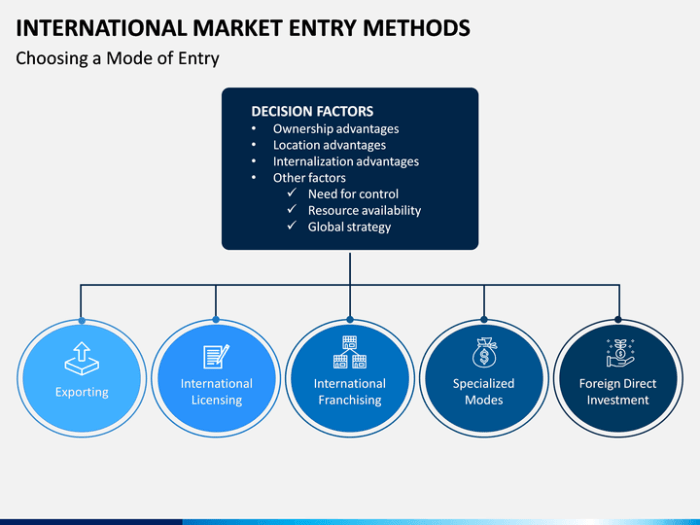Market Entry Strategies takes center stage as we dive into the realm of business maneuvers, exploring the key tactics that companies utilize to establish their presence in new markets. Get ready to uncover the secrets behind successful market entries!
From understanding the importance of market research to navigating cultural considerations, this topic delves into the intricacies of expanding businesses into uncharted territories.
Overview of Market Entry Strategies

Market entry strategies are the various methods and approaches that businesses use to enter a new market. These strategies are crucial for companies looking to expand their operations and reach new customers in different regions or countries. By carefully selecting the right market entry strategy, businesses can maximize their chances of success and minimize risks associated with entering unfamiliar markets.
Examples of Market Entry Strategies
- Exporting: Selling products or services to customers in a different country without establishing a physical presence.
- Joint Ventures: Partnering with a local company to enter a new market and share resources and risks.
- Franchising: Allowing independent operators to use your brand and business model in exchange for fees and royalties.
- Direct Investment: Setting up wholly-owned subsidiaries or facilities in a new market to have complete control over operations.
Advantages and Disadvantages of Market Entry Strategies
Each market entry strategy has its own set of advantages and disadvantages that businesses need to consider before making a decision:
- Exporting: Advantages include low initial investment and quick market entry, but disadvantages may include limited control over distribution and potential trade barriers.
- Joint Ventures: Advantages include shared risks and local expertise, but disadvantages may include conflicts with partners and sharing profits.
- Franchising: Advantages include rapid expansion and consistent brand image, but disadvantages may include less control over operations and revenue sharing.
- Direct Investment: Advantages include full control over operations and local market insights, but disadvantages may include high initial costs and risks associated with political instability.
Market Research for Market Entry: Market Entry Strategies

Market research plays a crucial role in the success of a market entry strategy. It provides valuable insights into the target market, consumer behavior, competition, and potential challenges that a company may face. By conducting thorough market research, businesses can make informed decisions and tailor their market entry strategy to suit the specific market dynamics.
Importance of Market Research, Market Entry Strategies
Market research helps businesses understand the market landscape, identify opportunities and threats, and assess the feasibility of entering a new market. It provides valuable data that can guide decision-making processes and minimize risks associated with market entry. Without proper market research, companies may struggle to understand the needs and preferences of their target customers, leading to ineffective market entry strategies.
Key Factors to Consider in Market Research
- Economic indicators and market trends
- Consumer demographics and behavior
- Competitor analysis and market saturation
- Regulatory environment and legal considerations
- Cultural nuances and social factors
Role of Market Research in Choosing Entry Strategy
Market research helps companies determine the most suitable market entry strategy by providing insights into the competitive landscape, consumer preferences, and potential barriers to entry. Whether a company opts for direct investment, joint ventures, licensing, or exporting, market research guides decision-making by highlighting the most effective approach based on the market conditions. By understanding the market dynamics through research, businesses can tailor their entry strategy to maximize success and minimize risks.
Types of Market Entry Strategies
In the world of business, there are various strategies that companies can use to enter new markets. These strategies can range from exporting goods to forming joint ventures with local partners. Choosing the right market entry strategy is crucial for the success of a company’s expansion efforts. Let’s delve into the different types of market entry strategies and how companies can select the most appropriate one.
Types of Market Entry Strategies
- Exporting: This strategy involves selling products or services to a foreign market. Companies can choose to export directly or use intermediaries like distributors.
- Joint Ventures: In a joint venture, two or more companies come together to form a new entity in the target market. This allows for shared resources and risks.
- Franchising: Franchising involves granting a license to a third party to operate under the company’s brand and business model. This can be a quick way to expand globally.
Criteria for Selecting Market Entry Strategy
- Market Size and Growth Potential: Companies should consider the size and growth rate of the target market when choosing a market entry strategy.
- Regulatory Environment: Understanding the regulations and policies of the target market is crucial in selecting a strategy that complies with local laws.
- Resource Availability: Companies need to assess their own resources and capabilities to determine which strategy is feasible for them.
Examples of Successful Companies
- Exporting: Nike successfully exports its athletic footwear and apparel to various countries around the world, maintaining a strong global presence.
- Joint Ventures: Starbucks formed a joint venture with Tata Group in India to establish Starbucks outlets in the country, leveraging Tata’s local expertise.
- Franchising: McDonald’s is a prime example of successful franchising, with thousands of franchise locations worldwide serving its popular fast food offerings.
Cultural Considerations in Market Entry
When expanding into new markets, it is crucial to consider the cultural differences that exist in various regions. In today’s globalized world, understanding and adapting to cultural nuances can make or break a company’s success in penetrating a new market. Let’s explore the significance of cultural considerations in developing market entry strategies and how they can impact the success of these strategies.
Impact of Cultural Differences
Cultural differences can greatly impact the success of market entry strategies. For example, communication styles, business etiquette, and consumer behavior can vary significantly between cultures. Failure to recognize and adapt to these differences can lead to misunderstandings, misinterpretations, and ultimately, market entry failure. Therefore, it is essential to conduct thorough research on the cultural aspects of the target market before formulating a market entry strategy.
- Language: The language spoken in the target market can significantly affect how a company communicates its brand message and value proposition. Adapting marketing materials and messages to the local language can enhance customer engagement and trust.
- Values and Beliefs: Cultural values and beliefs shape consumer preferences and purchasing decisions. Understanding and aligning with these values can help companies tailor their products or services to meet the needs and expectations of the local market.
- Business Practices: Business practices such as negotiation styles, decision-making processes, and relationship-building techniques can vary across cultures. Adapting to these practices can improve business relationships and foster trust with local partners and customers.
Strategies for Adapting Market Entry Approaches
Adapting market entry approaches to different cultural contexts requires a thoughtful and strategic approach. Companies can employ the following strategies to navigate cultural differences effectively:
- Localization: Tailoring products, services, and marketing strategies to suit the preferences and needs of the target market can enhance relevance and appeal to local consumers.
- Cultural Training: Providing cultural training to employees involved in market entry can help them develop cultural competence and navigate cultural nuances effectively.
- Partnerships: Forming partnerships with local businesses or organizations can provide valuable insights into the cultural landscape and facilitate smoother market entry.





